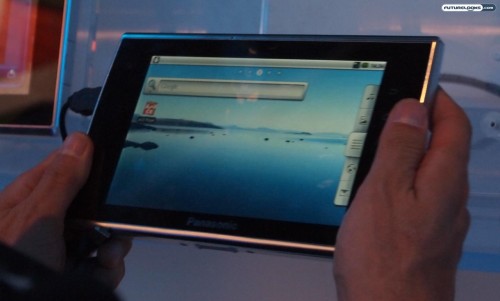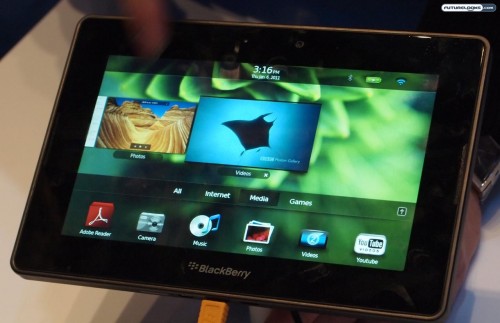
Our continuing coverage of the 2011 Consumer Electronics Show turns its attention over to a market that is quickly growing, expanding, and innovating: tablets. The Apple iPad remains the dominant force in this segment for now, but with the rise of Android 3.0 Honeycomb, NVIDIA Tegra2, and other great developments, it’s in for some stiff competition.
Along with the onslaught of tablets coming from what feels like every which direction, we’ll also be taking a quick stroll down the lane of netbook and notebook PCs. It’s all about having as much computing power as possible while hitting the road. It’s not like we can completely disconnect from the matrix, right?
BlackBerry PlayBook by Research in Motion

While our April Fool’s prank didn’t exactly come to fruition, Canada’s Research in Motion has still been keeping itself pretty busy. In addition to new BlackBerry smartphones being released now and then, they’re also working on a tablet.
The BlackBerry PlayBook has been delayed on more than one occasion, but we’re hearing that it should be ready for commercial consumption in the next few months. One of the keys here is that RIM has opted for a QNX-based user interface for its tablet and, let me tell you, it looks gorgeous in person. Instead of simulated multi-tasking, it offers real multi-tasking.
You know how you get thumbnail previews of your programs when you hover your mouse over the taskbar in Windows 7? The same kind of thing happens with the PlayBook, complete with videos playing in the background, webpages loading in the background, and more. Unfortunately, it’s Wi-Fi only, relying on a tethered (via Bluetooth) connection with your BlackBerry for mobile interwebz. A mobile network enabled version is in the works apparently.
MSI FR720 Notebook PC with Sandy Bridge

What about notebooks? MSI unleashed a huge lineup of laptops at the show. Some of them are geared toward the entertainment crowd. Some take their aim at the gaming market. And then there are several that just approach the more general notebook market. What they all have in common is Sandy Bridge.
MSI says that it is absolutely dedicated to Intel’s new platform (though they offer AMD-powered units too). One such example is the MSI FR720. The “F” in its name designates the more fashionable inclinations of this 17.6-inch desktop replacement. It’ll be offered in a few Sandy Bridge choices with prices to match. Why Sandy Bridge? Well, compared to previous generation Core i5 and i7 platforms, Sandy Bridge will not only be faster than the previous generation, but will also save battery life doing it thanks to more aggressive power management and the use of a new discrete graphics core right on the new processors.
Running through the specs, you get “next-gen Intel HD graphics” (integrated), MSI Premium Sound Technology with THX TruStudio Pro, a pair of USB 3.0 ports, built-in HD webcam, and a hard drive with up to 640GB of capacity.
Asus Eee PC 1215B Netbook
Turning our attention to our friends at Asus, we find that they are still quite commited to their Eee PC line of netbooks. In some ways, you could say that the Eee PC hasn’t changed all that much in recent years, but there are a few changes worth noting. In the case of the Eee PC 1215B, for example, you’ll find that it takes advantage of the new APU structure from AMD, which combines the CPU and GPU into a unified Brazos platform (aka AMD Fusion). This allows for full 1080p HD video playback via the Eee PC’s HDMI output.
Other noteworthy features include the 12.1-inch LED backlit WXGA display with a 16:9 wide aspect ratio, up to 4GB of RAM, up to 320GB hard drive, and the now characteristic chiclet keyboard.
Asus Eee Pad Transformer Tablet with Dock
We already touched on this product as part of our CES 2011 press day coverage, but it’s definitely worth revisiting. The whole tablet thing is pretty great, but sometimes you want to have a physical keyboard. That’s what you get with the Asus Eee Pad Transformer. The Android tablet is easily used on its own, just like any number of other tablets that you might find from other manufacturers, but there is also a keyboard docking station. When you put it in there, you get a real notebook experience (well, maybe closer to netbook).
What’s interesting is that, while it appears to be powered by an NVIDIA Tegra 2 chipset, the unit on display was only running on Android 2.2 Froyo. We hear that Android 3.0 Honeycomb could be ready for the Eee Pad Transformer when it launches in Q2. Otherwise, it’ll ship with Android 2.3 Gingerbread.
If you prefer a slightly different form factor, the Eee Pad Slider may be more your cup of tea. It comes with an integrated keyboard that slides out in landscape orientation. This is not unlike several different smartphones and quick messaging phones, albeit in a much larger scale.
GIGABYTE Is Ready To Compete in North America
We’ve always known that GIGABYTE had some interesting products hidden away in Taiwan. Yet our only glimpse here in North America was the original M912 Atom Convertible Tablet. Not any longer as CES 2011 marks a real push from their G-Style Mobile Computing Division.
Nicholas Kanter from GIGABYTE takes us through their new line-up which includes the S1080 Tablet, T1125 Transforming BookTop, and T1005 Tablet PC in this exclusive video preview.
It looks like everything we’ve seen in our many trips to Taiwan for COMPUTEX is finally arriving. GIGABYTE isn’t new to this market so expect them to be quite aggressive with these new products as they have been in the motherboard market.
Samsung 9 Series Superslim Notebook
Do you like the super-slim aesthetic offered by the MacBook Air, but you want something with a little more grunt (and some Windows) under the hood? Samsung is going beyond smarter homes by revealing the svelte Samsung 9 Series.
You want skinny? You’ve got skinny. Samsung is saying that this lappy measures just 0.68-inches thick, making it the slimmest and lightest 13-inch notebook on the market today. It gets its power from a Sandy Bridge processor that can turbo its way up to 2.3GHz for heavier lifting. It also tips the scales at a barely there 2.89 pounds, barely edging out the “MBA” in the featherlight competition.
Despite its slim stature, the Samsung 9 Series packs a 128GB SSD, 4GB RAM, integrated subwoofer (really?), Intel HD GT2 graphics, USB 3.0, Bluetooth 3.0, and mini-HDMI. Retail is expcted to be in the $1600 range and up.
Samsung Sliding PC 7 Series Tablet with Keyboard
It wouldn’t be at all fair to say that Samsung is copying Asus with this particular product, since they were both announced at the same CES, but you can see how these two items are remarkably similar. Remember that Asus Eee Pad Slider I was talking about? The Samsung Sliding PC 7 Series is kind of the same thing.
Like the Asus, the Samsung works as a tablet like how you’d expect it to do, but there’s also a full slide-out QWERTY keyboard hiding under there. With the keyboard exposed, you get closer to a notebook or netbook experience. One of the main differences between this hybrid and the Asus variant, though, is that it runs on Windows 7.
Instead of going with NVIDIA Tegra2, which isn’t exactly optimized for Windows, Samsung opted for the Intel Atom “Oak Trail” line of processors. This gives you 1.66GHz of juice to go along with the 10.1-inch screen, memory card reader, up to 64GB of storage, HDMI-out, and built-in webcam.
Personally, I’m not a fan of Windows on tablets and I think Android is a much better candidate for this kind of contraption. That said, Samsung says that it is mostly targeting the business traveler with a product like this, so it’s not exactly meant to be a consumer-level tablet. Expect to see this in March for about $699.
Panasonic VIERA Tablet Concepts
Just as I predicted in my CES preview article, the show floor was positively overflowing with tablets. The expectation with most of these devices is that they would become available through retail channels in the next few months. Such is not the case with Panasonic.
Rather than showing off some hot new Honeycomb goodness that we’d be able to buy before the summer, Panasonic has its range of VIERA tablets on display… all of which are prototypes that may or may not resemble the final product that likely won’t be available until very late 2011 or early 2012 at best. That’s the bad news. The good news is that Panasonic is showing some promise.
First, they’re working on tablets in a variety of sizes, including a smaller four-incher, a medium seven-incher, and a standard ten-incher. Second, via the VIERA Connect infrastructure, you’re able to use the VIERA tablet as a remote for your TV, quite literally “pushing” (with a vertical swipe) videos you see on your tablet to your VIERA HDTV.
Archos Internet Tablets with Android
Yes, there is a big push toward tablets at this year’s show, but it’s not like the idea is particularly novel. Archos has been doing the Internet tablet thing for several years, but they just don’t get the same kind of attention as a Motorola or Apple.
Like the VIERA Tablet, Archos tablets come in a big range of sizes. One example is the Archos 70 Internet tablet with its seven-inch screen. There’s a 1GHz processor, 250GB hard drive, and a stainless steel structured slim and light design. Unfortunately, for whatever reason, they’re shipping this tablet with Android 1.6. Get with the times, Archos! At least it’s relatively cheap with its $350 MSRP.
Technology Has Gone Mobile
If there are two take-home messages from CES, they’re this: First, everyone wants to keep computing and stay connected on the road. Smartphones are good, but tablets offer a bigger screen with decent battery life. Second, we seem to like touchscreens. Don’t expect that to change for several years, if ever.
Should the iPad be worried? Probably not yet, but 2012 could be a huge year for Android tablets after these manufacturers get past their respective first-gen hiccups.
Love This Coverage? Hate This Coverage? Leave a Comment or Hit The Forums!
CES 2011 – Tablets, Notebooks, and Netbooks – Image Gallery
